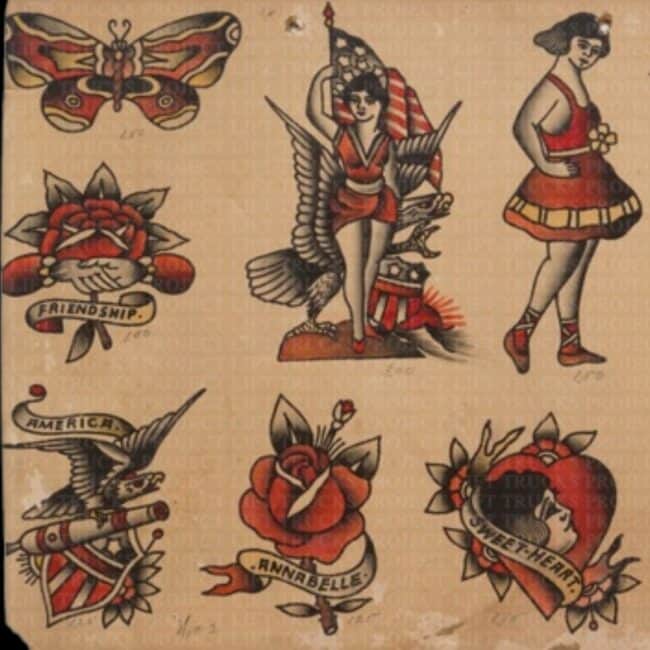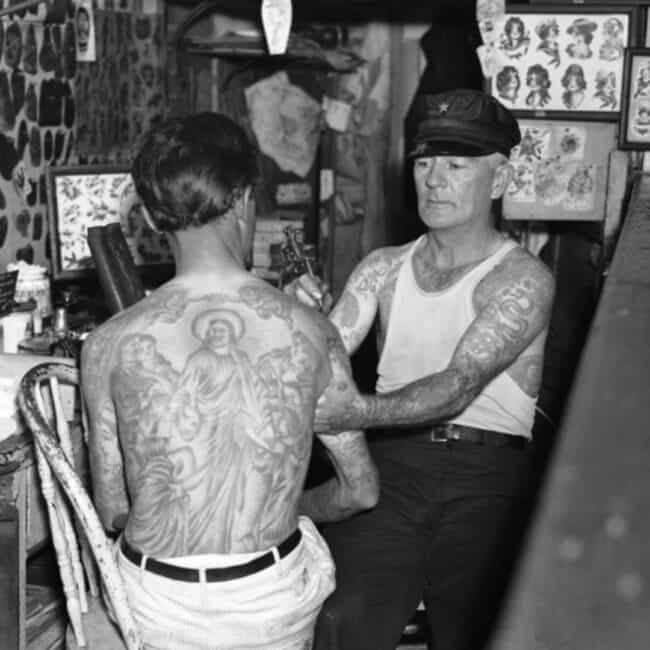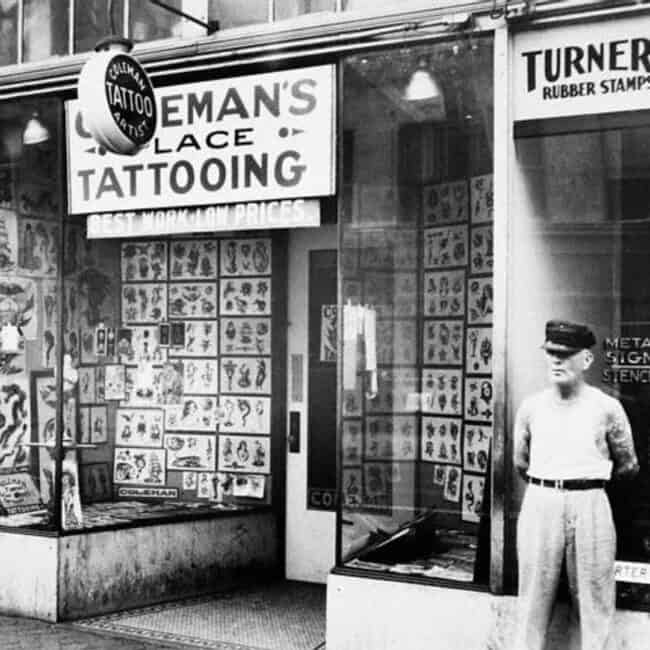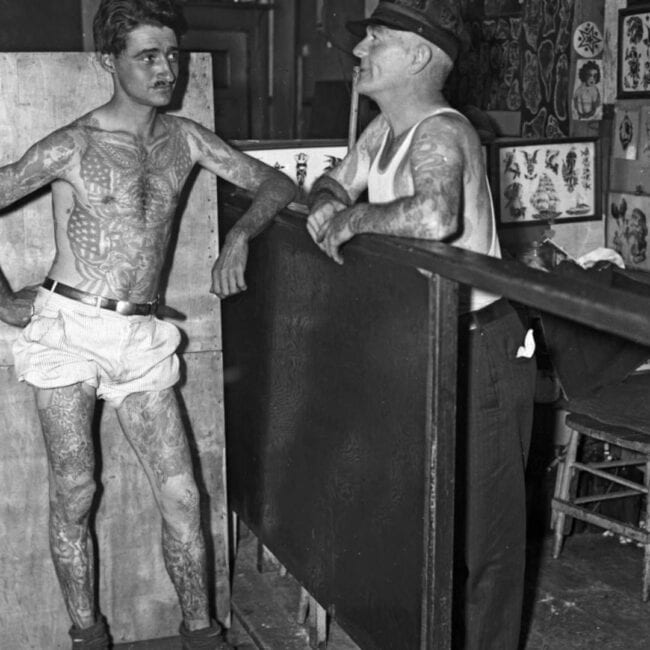The Enigmatic Legacy of Cap Coleman: The Godfather of Tattooing

August Bernard “Cap” Coleman (15 October 1884 – 20 October 1973) stands as a giant in the history of tattooing. Renowned as “The Godfather of American Tattooing,” Coleman’s groundbreaking designs and exceptional skills left a lasting legacy, influencing tattooists for generations, including the likes of Franklin Paul Rogers and Sailor Jerry. Despite his celebrated status, much of Coleman’s life remains shrouded in mystery, with details emerging like the intricate designs he etched onto the skin of his clients.
Humble Beginnings and Carnival Roots
Born in 1884 near Cincinnati, Ohio, Coleman hailed from a family believed to have ties to the carnival circuit. This itinerant lifestyle likely ignited his early interest in tattoos, as carnivals during the late 19th and early 20th centuries were hotspots for tattoo artistry. Known as “The Human Picture Gallery,” Coleman began his career both as a tattooed sideshow performer and as a tattoo artist with attractions like the Greater Smith Shows and Sheesley Shows.
There is some conjecture that Coleman’s father, Anthony, may have been a tattooist, but historical records offer scant evidence to support this claim. Paul Rogers, a tattooist who later worked alongside Coleman, was sceptical of the story. Regardless, Coleman’s formative years were steeped in the colourful and chaotic world of carnival life, where he cultivated his craft and developed the distinctive style that would later cement his reputation.
Tattoo Apprenticeship and Early Mastery

By 1912, Coleman had begun his formal training, seeking to refine his artistic abilities and deepen his understanding of the craft. He apprenticed under Jesse Frederick Barber, a respected tattoo artist who operated a studio on Vine Street in Cincinnati, Ohio. Under Barber’s watchful eye, Coleman gained not only technical expertise but also learned the business side of tattoo artistry, absorbing the finer points of professional success. It was during this time that Coleman began to embrace the title of “Professor,” a nod to the high regard in which he held his own skill and knowledge. As he grew in his artistry, he made the bold decision to open his own studio, confident that his talent could set him apart.
During these formative years, Coleman’s designs began to emerge as distinctive works of art. He developed an ability to merge bold, heavy lines with delicate, intricate details—a combination that would later become his signature style. His tattoos were no longer just ink on skin but intricately crafted visual statements. Clients were drawn to his artistic flair, particularly in his ability to breathe new life into traditional motifs like anchors, eagles, and skulls. This mix of innovation and homage to established tattoo designs led to Coleman quickly building a dedicated and loyal following. His reputation spread far beyond the borders of Cincinnati, with many tattoo enthusiasts seeking him out for the unique artistry he brought to their bodies.
Building a Legacy in Norfolk

In 1918, Coleman relocated to Norfolk, Virginia, a thriving naval hub during World War I. Setting up shop on East Main Street, he catered to sailors and servicemen, whose strong demand for tattoos helped fuel his booming business. The lively port city, with its eclectic blend of tattoo parlours and entertainment spots, provided the perfect setting for Coleman’s creative work.
Coleman’s tattoos were renowned for their bold lines, intricate shading, and striking designs. His flash sheets, featuring iconic motifs like eagles, ships, and patriotic imagery, became instantly recognisable and widely copied. At the heart of his shop stood a statue covered in Coleman’s tattoo art, a testament to his commitment to pushing boundaries and perfecting his craft. This statue now resides in the Mariner’s Museum in Newport News, Virginia.
A Shrewd Businessman

Coleman was just as sharp in business as he was with a tattoo machine. His two-sided business card flaunted his reputation with style, listing features in well-known magazines and displaying his photo, but cleverly leaving out his shop’s address—confidently stating, “Look for Coleman’s place on Main Street.” He also ventured into selling tattoo supplies, including needles and stencils, and promoted his patented “sanitary tubes,” though no patents have ever been found under his name.
On top of this, Coleman seized the growing interest in tattoos by creating instructional materials for budding tattooists, though the details of these materials are still debated by historians. Some claim these guides were basic, while others believe they offered in-depth insights into his techniques.
The Tattoo Ban and a New Chapter
The golden age of tattooing in Norfolk came to an abrupt end in 1950 when the City Council passed a law banning tattoo establishments, citing public health concerns. Coleman, along with other tattoo artists, moved across the Elizabeth River to Portsmouth, Virginia, where he kept on with his work. Despite the move, his loyal customers followed, ensuring his business remained strong.
Interestingly, this time period saw a change in Coleman’s style. Some of his later tattoos show a shift from the bold, traditional designs of his early years, incorporating softer lines and more experimental motifs. This evolution highlighted his ability to adapt and his ongoing dedication to innovation.
A Life Shrouded in Mystery

Despite his high profile, Coleman’s life remained shrouded in mystery. Census records and draft registrations show inconsistencies about his birthplace, with stories ranging from Ohio to San Francisco, California. His German heritage and carnival background only added to the enigma. Coleman’s personality was just as complex—described by Paul Rogers as shrewd and reserved, he was a man who knew his worth and was determined to maintain his independence.
One intriguing detail is Coleman’s apparent reluctance to document his career in detail. Unlike his contemporaries, such as Sailor Jerry, who left behind a wealth of written letters and photographs, Coleman’s legacy is pieced together from stories, scattered records, and the tattoos he left behind.
Coleman made shrewd investments in the stock market, building a modest fortune. When he passed away on October 20, 1973, from an accidental drowning in the Elizabeth River, he left his wealth to several charitable causes, including the Virginia School for the Deaf and the St. Mary’s Infants Fund. Some have even speculated that his financial savvy may have been just as instrumental to his success as his artistic abilities.
The Enduring Influence of Cap Coleman

Cap Coleman’s legacy is a cornerstone of tattoo history. His contributions to the craft, from his pioneering designs to his mastery of technique, continue to inspire tattooists around the world. The elusive details of his life only add to his mystique, making him a figure as vibrant and enduring as the tattoos he created.
Coleman’s story stands as a testament to the resilience of artistry in the face of societal changes and personal challenges. His work remains a vivid reminder of the transformative power of tattooing, etched not just on skin but into the very fabric of tattoo culture. To this day, tattoo artists studying his work often remark on the lasting relevance of his designs—a true mark of genius.
The man behind the legend may forever remain an enigma, but his influence on tattooing is etched into history, just as indelibly as the designs he inked on countless clients.
The Coleman Legacy Continues
At CB Ink, we pay tribute to legends like Cap Coleman by continuing their tradition of top-notch, timeless tattoo artistry. If his story gets you fired up to wear your own piece of history, our talented artists are ready to bring your vision to life. Whether you’re after classic designs, bold back pieces, or something completely unique, let us help you carry on the legacy of tattoo art—one ripper design at a time.
If you’re ready to get your next tattoo, book an appointment today!
If you still have some questions or concerns, feel free to send us a message and we’ll be glad to help!